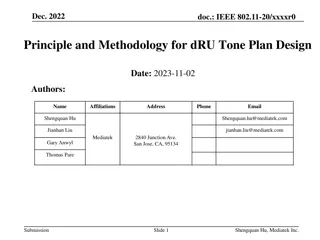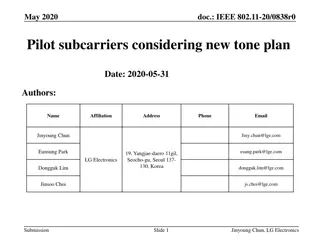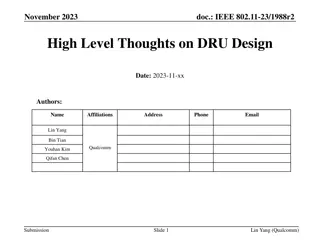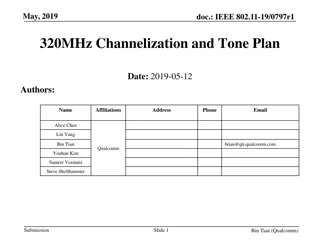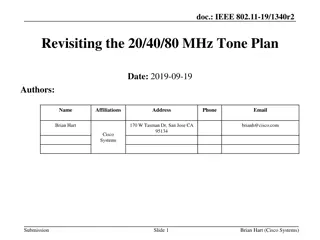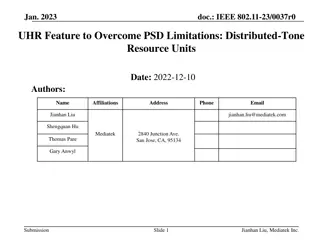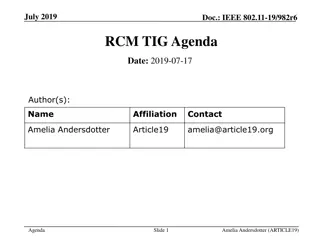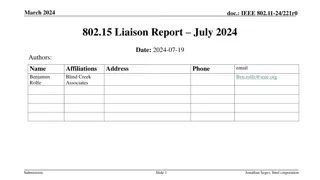Tone Plan Design for Distributed RU in IEEE 802.11 Standards
This document discusses the design of tone plans for Distributed Remote Units (DRUs) in IEEE 802.11 standards. Three main tone plans are proposed: Group based tone plan, Pilot tone power boosted tone plan, and Unified DRU Tone Plan. The group based tone plan focuses on separating pilots, reducing channel coefficient errors, and allocating tones strategically. Detailed examples of tone plans and pilot designs for various bandwidths are provided.
Download Presentation

Please find below an Image/Link to download the presentation.
The content on the website is provided AS IS for your information and personal use only. It may not be sold, licensed, or shared on other websites without obtaining consent from the author.If you encounter any issues during the download, it is possible that the publisher has removed the file from their server.
You are allowed to download the files provided on this website for personal or commercial use, subject to the condition that they are used lawfully. All files are the property of their respective owners.
The content on the website is provided AS IS for your information and personal use only. It may not be sold, licensed, or shared on other websites without obtaining consent from the author.
E N D
Presentation Transcript
March 2024 doc.: IEEE 802.11-xx/xxxxr0 Tone Plan Design for Distributed RU Date: 2024-XX-XX Authors: Name Bo Gong Zhi Mao Junghoon Suh Jian Yu (Ross) Affiliations Address Phone Email gongbo8@huawei.com maozhi3@huawei.com Junghoon.Suh@huawei.com Huawei ross.yujian@huawei.com Ming Gan ming.gan@huawei.com Submission Slide 1 Bo Gong (Huawei)
March 2024 doc.: IEEE 802.11-xx/xxxxr0 Introduction In [1], maximum power amplification and the same hierarchical structure with rRU has been discussed for DRU tone plan design. Based on the above two principles, we propose 3 kinds of tone plans including Opt-1 : Group based tone plan Opt-2 : Pilot tone power boosted tone plan Opt-3 : Unified DRU Tone Plan across the BWs Submission Slide 2 Bo Gong (Huawei)
March 2024 doc.: IEEE 802.11-xx/xxxxr0 Opt-1 : Group based Tone Plan and Pilot Design Main points of the group based tone plan can be summarizes as follows: The pilots in the whole bandwidth should be separated enough with each other to avoid the effect of narrowband interference. The pilots should be placed inside a group of tones to reduce the smoothing fitting error of the channel coefficients of the pilot tones. The reason is that for the interpretation of a PPDU, the pilot tones are more sensitive and more important, whilst the data tones are more robust due to the channel coding (e.g., LDPC). Based on the above, group based tone plans have been designed. In the following, 20MHz group based tone plan is given as an example and 40M/80M/160M group based tone plan can be obtained in the same way. Submission Slide 3 Bo Gong (Huawei)
March 2024 doc.: IEEE 802.11-xx/xxxxr0 An Example Tone Plan for 20M Bandwidth 1 2 3 4 5 6 7 8 9 10 11 12 13 14 15 16 17 18 19 20 21 22 23 24 25 26 27 28 29 30 31 32 33 34 35 36 37 38 39 40 41 42 52-tone DRU1 52-tone DRU2 52-tone DRU3 52-tone DRU4 For 256 FFT, there exists 242 tones with indexes [-122:-2, 2:122]; For 52-tone DRU design, one tone and two adjacent tones are allocated to four 52-tone DRUs in turn. The 26-tone DRUs consist of the odd/even tones of the 52-tone DRUs. The 106-tone DRUs are the combination of two 52-tone DRUs with additional 2 tones. 43 44 45 46 47 48 49 50 51 52 53 54 55 56 57 58 59 60 61 62 63 64 65 66 67 68 69 70 71 72 73 74 75 76 77 78 79 80 81 82 83 84 85 86 87 88 89 90 91 92 93 94 95 96 97 98 99 100101102103104105106 107 108 109 110 111112113114115116117118119 120 121 122 123 124 125126127128129130131132133 134 135 136 137 138 139 140 141 142143144145146147148149150 151 152 153 154 155 156157158159160161162163164 165 166 167 168 169 Maximum power amplification for DRU is achieved under the same hierarchical structure as rRU: Nine 26-tone DRUs : 13/2 = 6.5 (8.13dB) Four 52-tone DRUs : 13/3 = 4.3 (6.37dB) Two 106-tone DRUs : 13/6 = 2.17 (3.36dB) 170171172173174175176177178 179 180 181 182 183 184185186187188189190191192 193 194 195 196 197 198199200201202203204205206 207 208 209 210 211 212213214215216217218219220 221 222 223 224 225 226227228229230231232233234 235 236 237 238 239240241242 Submission Slide 4 Bo Gong (Huawei)
March 2024 doc.: IEEE 802.11-xx/xxxxr0 An Example Pilot Design for 20M Bandwidth 1. Each 52-tone DRU includes 17 pairs of tones. For the four 52-tone DRUs, the i-th pair of tones are continuous, referred as a block here. Beside the 9-th block which is near to the DC tones, each remaining block includes one pilot tone to avoid clustering of the pilot tones. There exist 16 remaining blocks, which correspond to 16 pilot tones. 1 2 3 4 5 6 7 8 9 10 11 12 13 14 15 16 17 18 19 20 21 22 23 24 25 26 27 28 29 30 31 32 33 34 35 36 37 38 39 40 41 42 52-tone DRU1 52-tone DRU2 52-tone DRU3 52-tone DRU4 43 44 45 46 47 48 49 50 51 52 53 54 55 56 57 58 59 60 61 62 63 64 65 66 67 68 69 70 71 72 73 74 75 76 77 78 79 80 81 82 83 84 2. tones distributed evenly. Utilizing the seventh or eighth tone in the 1st/5th/10th/14th block as the pilot tone, which locates in the fourth 52-tone DRU; Utilizing the fifth or sixth tone in the 2nd/6th/11th/15th block as the pilot tone, which locates in the third 52-tone DRU; Utilizing the third or fourth tone in the 3rd/7th/12th/16th block as the pilot tone, which locates in the second 52-tone DRU; Utilizing the first or second tone in the 4th/8th/13th/17th block as the pilot tone, which locates in the first 52-tone DRU; To reduce the distance between the pilot tone and the guard tones and to keep the pilot 85 86 87 88 89 90 91 92 93 94 95 96 97 98 99 100101102103104105106 107 108 109 110 111112113114115116117118119 120 121 122 123 124 125126127128129130131132133 134 135 136 137 138 139 140 141 142143144145146147148149150 151 152 153 154 155 156157158159160161162163164 165 166 167 168 169 170171172173174175176177178 179 180 181 182 183 184185186187188189190191192 193 194 195 196 197 198199200201202203204205206 207 208 209 210 211 3. The pilot tones of 26-tone DRUs are split from 52-tone DRUs. The pilots of the 106-tone DRUs can be selected as the same as any included 52-tone DRU. 212213214215216217218219220 221 222 223 224 225 226227228229230231232233234 235 236 237 238 239240241242 Submission Slide 5 Bo Gong (Huawei)
March 2024 doc.: IEEE 802.11-xx/xxxxr0 Simulation Results Channel Bandwidth = 20MHz LDPC Coding, MCS = 0/MCS = 7 SISO with Channel Model D, no impairment Phase tracking is always used Packet Size = 2000 bytes The PER for the first 52-tone DRU is considered The baseline scheme is a 52-tone DRU which is near-evenly distributed. The space between two adjacent subcarriers is 4 or 5 that alternately appears. BW = 20MHz, MCS = 0, LDPC, Channel D The simulation results show that under low SNR 100 proposed paired tone plan without smoothing proposed paired tone plan with smoothing near-evenly distributed tone plan without smoothing near-evenly distributed tone plan with smoothing The performance of the proposed group based tone plan is similar to the near evenly distributed tone plan with/without smoothing. 10-1 PER There exists obvious smoothing gain for the proposed group based tone plan and the near evenly distributed tone plan. 10-2 10-3 10-4 0 1 2 3 4 5 6 7 8 SNR(dB) Submission Slide 6 Bo Gong (Huawei)
March 2024 doc.: IEEE 802.11-xx/xxxxr0 Simulation Results The simulation results show that under high SNR BW = 20MHz, MCS = 7, LDPC, Channel D 100 (1) The performances of the proposed paired tone plan and the near-evenly distributed tone plan are almost the same if without smoothing. proposed paired tone plan without smoothing proposed paired tone plan with smoothing near-evenly distributed tone plan without smoothing near-evenly distributed tone plan with smoothing (2) The performance of the near-evenly distributed tone plan deteriorates with smoothing for the larger fitting error. PER 10-1 (3) For the proposed group based tone plan, there still exists obvious smoothing gain. The reason is that on the one hand, the paired tones are close to each other and are the dominant contributors for each other s smoothed channel coefficients; on the other hand, the pilot tones are included by the paired tones. 10-2 21 21.5 22 22.5 23 23.5 24 24.5 25 SNR(dB) Submission Slide 7 Bo Gong (Huawei)
March 2024 doc.: IEEE 802.11-xx/xxxxr0 Opt-2: DRU Tone Plan with Pilot Boost Motivation: Pilot power of some dRUs can be further boosted because of the power boost gap between the transmit power of a dRU and maximum power in a PPDU. 26-tone dRU in a 20 MHz PPDU; 52-tone dRU in a 40 MHz PPDU; 106 and 242-tone dRU in a 80 MHz PPDU; May have some dRUs in a PPDU with BW larger than 80 MHz. Distributed Tone RU (dRU) for Power Boost in 6GHz LPI [1] dRU Tx Power rRU Tx Power (dBm) 20 MHz PPDU dRU BW20 (dBm) 40 MHz PPDU dRU BW40 (dBm) 80 MHz PPDU dRU BW80 (dBm) 160 MHz PPDU dRU BW160 (dBm) RU Size Tone Num. per MHz Power Boost Gap (dB) 1.56 1.56 ( (11.77-10.21) ) 0.31 ( (11.77-11.46) ) 0.23 ( (11.77-11.54) ) Tone Num. per MHz Power Boost Gap (dB) Tone Num. per MHz Power Boost Gap (dB) Tone Num. per MHz Power Boost Gap (dB) RU26 2.08 10.21 13.22 13.22 13.22 N/A 2 1 1 N/A 1 N/A 1.56 1.56 RU52 5.09 11.46 13.22 16.23 16.23 3 2 1 N/A 1 N/A ( (14.78-13.22) ) 0.23 ( (14.78-14.55) ) 0.32 ( (14.78-14.46) ) 1.6005 1.6005 ( (17.91-16.31) ) 1.0205 1.0205 ( (17.91-16.89) ) 0.4405 ( (17.91-17.47) ) RU106 8.18 11.54 14.55 16.31 6 3 2 1 19.32 N/A 1.02 RU242 11.77 14.46 16.89 2 19.90 / / / 7 4 (20.92 -19.90) 1.02 (20.92 - 19.90) 0.32 (20.92 -20.60) RU484 14.78 17.47 4 19.90 / / / / / / 7 RU996 17.91 / / / / / / / / / 7 20.60 RU2*996 20.92 / / / / / / / / / Note 1: N/A means that there is no potential boost room because the dRU is totally distributed (i.e., one tone per MHz); Note 2: The related dRUs with red items can be further boosted because there is a power boost gap between the dRU power and PPDU power; Note 3: rRU Tx Power: 10*log10(NumTone*0.078125)-1. Bo Gong (Huawei) Submission Slide 8
March 2024 doc.: IEEE 802.11-xx/xxxxr0 Proposed Tone Plan for BW20 Design thoughts Dividing tones into two subgroups: Subgroup1 for 26-tone dRU 1-5; Subgroup2 for 26-tone dRU 6-9; Pilot tones in subgroup1 is surrounded by data tones in subgroup2; In frequency domain between two pilot locations, repeat Subgroup1 and Subgroup2 alternatively for data tone design; Tone plan structure (DC_leftPart or DC_rightPart) [28DataTones(2*5, 2*4, 2*5), PilotTones1*4, 28DataTones(2*5, 2*4, 2*5), 26DataTones(2*4, 2*5, 2*4), PilotTones1*5, 26DataTones(2*4, 2*5, 2*4)] Pilot Locations DC_rightPart DC_leftPart Benefits of proposed 26-tone dRU 1 pilot tone per MHz. The tone distance between a pilot tone and a nearest data tone is larger than or equal to 13; 2 data tones per MHz. Submission Slide 9 Bo Gong (Huawei)
March 2024 doc.: IEEE 802.11-xx/xxxxr0 Proposed Tone Plan for BW20 Power boost gain of proposed 26-tone dRU Data Tone Num. per 1MHz Power Boost per tone (dB) Pilot Tone Num. per MHz Power Boost per tone (dB) 8.13 (-12.14 -4.01 ) 11.13(-12.14 -1.01) 26-tone dRU 2 1 3 dB power boost Power boost gain of 52,106-tone dRUs 3 tones per MHz in 52-tone dRUs; 6 tones per MHz in 106-tone dRUs Submission Slide 10 Bo Gong (Huawei)
doc.: IEEE 802.11-xx/xxxxr0 March 2024 Proposed Tone Plan for Other BWs Tone plan structure (DC_leftPart or DC_rightPart) [28DataTones(2*5, 2*4, 2*5), PilotTones1*4, 28DataTones(2*5, 2*4, 2*5), 26DataTones(2*4, 2*5, 2*4), PilotTones1*5, 26DataTones(2*4, 2*5, 2*4)] N N=2, if BW40; N=4, if BW80; N=8, if BW160; Note: N denotes the N times repeating in frequency domain. Other consideration Distributing null tones in rRUs tone plan to the location near DC or guard in dRUs tone plan Power boost gain of pilots. Refer to the Appendix. Summary We propose a dRU tone plan with pilot power boost consideration as Opt-2. The power boost gap in some dRUs is narrowed. Submission Slide 11 Bo Gong (Huawei)
March 2024 doc.: IEEE 802.11-xx/xxxxr0 Option 3: Unified DRU Tone Plan across the BWs 12 Guard Tones 11 Guard Tones -117 Guard Tones 2 117127 -128 -2 20 MHz 5 DC DC 11 Guard Tones 12 Guard Tones -245 Null Tones 126130 5 Null Tones -130-126 Tones -256 245255 11 -11 40 MHz 5 Null 23 DC 11 Guard Tones 12 Guard Tones -501 382386 5 Null Tones -130-126 5 Null Tones 126130 5 Null Tones -386-382 5 Null Tones 501511 267 -512 -245 11 -11 245 -267 80 MHz 23 Null Tones 23 Null Tones 23 DC Guard Tones on one side are aligned with the larger BW Guard Tones on the other side are aligned with the half of the DC tones in the larger BW Null Tones are aligned with the Null Tones in the larger BW and the DC Tones are aligned with the same number of Null Tones in the larger BW STAs with the different Operating BW can be mix-scheduled Ex. 20 MHz DRU can be mix-scheduled with the 40 MHz DRU in a 40 MHz OFDMA PPDU Ex. 40 MHz DRU can be mix-scheduled with the 80 MHz DRU in a 80 MHz OFDMA PPDU Ex. 20, 40 and 80 MHz DRU can be mix-scheduled in a 80 MHz OFDMA PPDU DRUs (including data + pilots) occupy the rest of tones excluding the DC, Guard Tones and Null Tones Additional Null tones may arise depending on the DRU design, in this case the additional null tones may be put beside the DC and Guard Tones Submission Slide 12 Bo Gong (Huawei)
March 2024 doc.: IEEE 802.11-xx/xxxxr0 In case of preamble puncturing case, we can apply the sub-bandwidth DRU tone plan individually Ex. For 20+40 MHz puncturing case in 80 MHz PPDU, we can apply the 20 MHz DRU tone plan and 40 MHz DRU tone plan to the non-punctured frequency portion and schedule the PPDU to the same STA A mixed RRU and DRU mode can be applied to a preamble-punctured PPDU Ex. For 20+40 MHz puncturing case, an RRU can be scheduled to 20 MHz portion and a DRU can be scheduled to 40 MHz portion Main purpose of this Option 3 DRU design is to allow a mixed-schedule among the STAs with the different operating BW Ex. In case of four 20 MHz STAs and two 40 MHz STAs to be scheduled, one way to schedule is to apply 52- tone 20 MHz tone plan for the 20 MHz STAs and 106-tone 40 MHz tone plan for the 40 MHz STAs Let s denote STA1 through STA4 as 20 MHz STAs and STA5 and STA6 as 40 MHz STAs One mixed-schedule is shown in detail in the following link as in the Excel spreadsheet below STA1 through STA6 are scheduled together in one 40 MHz PPDU STA1 and STA2 are scheduled in the 20 MHz portion of lower tone index (STA1 and STA2 are assumed to park in the primary 20 MHz) STA3 and STA4 are scheduled in the 20 MHz portion of higher tone index (STA3 and STA4 are assumed to park in the secondary 20 MHz) Submission Slide 13 Bo Gong (Huawei)
March 2024 doc.: IEEE 802.11-xx/xxxxr0 Summary In this proposal, we propose 3 kinds of tone plans. Beside the maximum power amplification and the same hierarchical structure with rRU, they have the following properties. For opt-1, the group based tone plan reduces the smoothing fitting error of the pilot tones by placing the pilot tone inside a group of tones. Simulation results show obvious gain of the proposed group based tone plan. For opt-2, the pilot power boosted tone plan improves the power of the pilot tones, which guarantees higher phase tracking accuracy. For opt-3, the unified DRU tone plan supports mixed scheduling across the BWs. Submission Slide 14 Bo Gong (Huawei)
March 2024 doc.: IEEE 802.11-xx/xxxxr0 Straw Poll #1 Do you agree to add the following text to the TGbn SFD? - The DRU sizes include 26-tone, 52-tone, 106-tone, 242-tone, 484-tone, 996-tone. Y/N/A: // Submission Slide 15 Bo Gong (Huawei)
March 2024 doc.: IEEE 802.11-xx/xxxxr0 Straw Poll #2 Do you agree to add the following text to the TGbn SFD? rRU tone plan, which means - Each 52-tone DRU consists of two 26-tone DRUs; - Each 106-tone DRU consists of two 52-tone DRUs and two additional tones; - Each 242-tone DRU consists of two 106-tone DRUs and one 26-tone DRU and 4 additional tones; The DRU tone plan for 20M/40M distribution bandwidth presents the same hierarchical structure as Y/N/A: // Submission Slide 16 Bo Gong (Huawei)
March 2024 doc.: IEEE 802.11-xx/xxxxr0 Straw Poll #3 Do you agree to add the following text to the TGbn SFD? same size The number of the pilot tones of a DRU is the same as the number of the pilot tones of a rRU with the - Four pilots for 52-tone DRU; - Four pilots for 106-tone DRU; - Eight pilots for 242-tone DRU; - Sixteen pilots for 484-tone DRU. - Sixteen pilots for 996-tone DRU. - Two pilots for 26-tone DRU; Y/N/A: // Submission Slide 17 Bo Gong (Huawei)
Month Year doc.: IEEE 802.11-xx/xxxxr0 Straw Poll #4 Do you agree with the mixed-scheduling in DRU Tone Plan? - Mixed-scheduling takes place in a PPDU where the STAs with the different operating BWs are scheduled together - The BW of the PPDU is aligned with the largest operating BW among the scheduled STAs Submission Slide 18 Bo Gong (Huawei)
Month Year doc.: IEEE 802.11-xx/xxxxr0 Straw Poll #5 Do you agree with the Unified DRU Tone Plan? - Unified DRU Tone Plan is that the DRU Tone Plan of a larger size BW gets built up over the tone plan of the smaller size BW - e.g.) the 40 MHz DRU Tone Plan is built up over the 20 MHz DRU Tone Plan, so the 20 MHz operating STAs can be scheduled with the 40 MHz operating STAs in one 40 MHz PPDU Submission Slide 19 Bo Gong (Huawei)
Month Year doc.: IEEE 802.11-xx/xxxxr0 Straw Poll #6 Do you agree with the following DRU Tone Plan to support the Unified DRU Tone Plan? - The DRU sizes include 26-tone, 52-tone, 106-tone, or combination of these DRUs - Combination of DRUs is TBD Submission Slide 20 Bo Gong (Huawei)
March 2024 doc.: IEEE 802.11-xx/xxxxr0 References [1] 11-23-2021-00-00bn-principle-and-methodology-for-dru-tone-plan-design [2] 11-23-2020-01-00bn-high-level-perspective-on-distributed-tone-ru-for-11bn Submission Slide 21 Bo Gong (Huawei)
March 2024 doc.: IEEE 802.11-xx/xxxxr0 Appendix : Example of 52-tone dRU on BW40 Data Tone Num. per 1MHz Power Boost per tone (dB) Pilot Tone Num. per MHz Power Boost per tone (dB) 52-tone dRU 2 8.13 (-12.14 -4.01 ) 1 11.13 (-12.14 -1.01) Submission Slide 22 Bo Gong (Huawei)
March 2024 doc.: IEEE 802.11-xx/xxxxr0 Appendix : Example of 106-tone dRU on BW80 Power Boost per tone (dB) Power Boost per tone (dB) Data Tone Num. per 1MHz Pilot Tone Num. per MHz 8.13 11.13 106-tone dRU 2 1 (-12.14 -4.01 ) (-12.14 -1.01) Submission Slide 23 Bo Gong (Huawei)
March 2024 doc.: IEEE 802.11-xx/xxxxr0 Appendix : Example of 242-tone dRU on BW80 Data Tone Num. per 1MHz Power Boost per tone (dB) Pilot Tone Num. per MHz Power Boost per tone (dB) 5.12 8.13 242-tone dRU 4 2(equivalent) (-12.14 -7.02) (-12.14 -4.01) Submission Slide 24 Bo Gong (Huawei)
March 2024 doc.: IEEE 802.11-xx/xxxxr0 Appendix : Example of 242-tone dRU on BW160 Power Boost per tone (dB) Power Boost per tone (dB) Data Tone Num. per 1MHz Pilot Tone Num. per MHz 6.37 1.5 9.37 242-tone dRU 3 (-12.14 -5.77 ) (equivalent) (-12.14 -2.77) Submission Slide 25 Bo Gong (Huawei)
March 2024 doc.: IEEE 802.11-xx/xxxxr0 Appendix : Example of 484-tone dRU on BW160 Data Tone Num. per 1MHz Power Boost (dB) Pilot Tone Num. per MHz Power Boost (dB) 5.12 2 8.12 484-tone dRU 4 (-12.14 -7.02 ) (equivalent) (-12.14 -4.02) Submission Slide 26 Bo Gong (Huawei)


